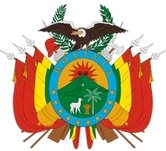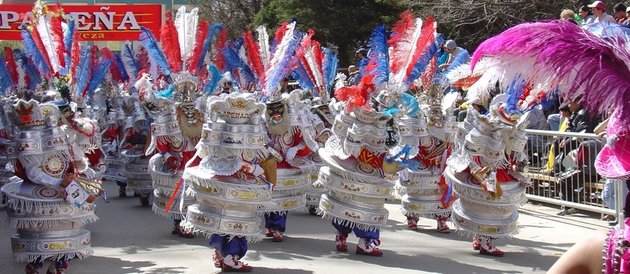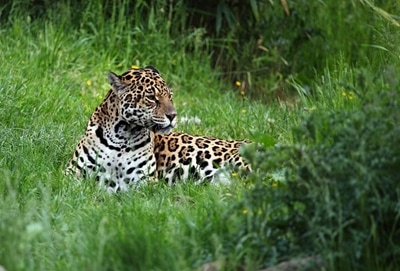Celebration, Colour & Carnival in Colonial Bolivia
|
With some four dozen native groups making up half of the Bolivian population, the largest proportion of indigenous people in Latin America, the ethnic composition of Bolivia is extremely diverse. These include the high Andean people, such as the Aymara, Uru and Quechua (who formed the Inca empire), and the three dozen or so eastern, lowland people such as the Guaranies, Tobas, Araucos, Moxos, etc. In addition, Spanish colonization, and immigration from Africa and even Japan and Lebanon, has resulted in even more diversity from outside. The large Mennonite, Amish and Jesuit communities in eastern Bolivia further enrich this mix. Thereby offering celebration, colour and Carnaval like no other, Bolivia celebrates a huge variety of festivals and presents such culturally different destinations that visitors may wish to add to their main visit program as interests and location permit.
Here are some of our favourites! |
Celebrations: Bolivia hosts MORE celebrations than any other country in South America, in EVERY month of the year! Here we list the most important, the most colourful, and the most bizarre!
Alasitas (Jan)
|
|
Alasitas: (annually in January) - Just before Carnaval, La Paz hosts the colourful festival of "Alasitas", when Ekeko, the "abundance god" is revered. In a month long frenzy, locals buy miniature gifts of every describable nature from Alasitas stalls in the streets and parks, pinning the items on their Ekeko doll so that these may become reality for them or their loved ones in the coming year. Ekeko himself is kept content with gifts of cigarettes and alcohol! An AMAZING time to experience the ages-old, rich culture of Bolivia, it is also a GREAT opportunity to purchase quality handicraft in the colourful local markets! |
Festival of Oruro (Feb/Mar)
|
|
Festival of Oruro: (Saturday before Ash Wednesday annually in February) - A UNESCO Heritage event that is also Bolivia's largest annual celebration, the Carnaval de Oruro competes with the Rio Carnival in terms of size (400,000 visitors; 28,000 dancers and 12,000 musicians), noise and colour! Held over 5 days, the culmination is the "Diablada" (Dance of the Devils), the "god protector of mines". Featuring exotic costumes and dance from all over Bolivia, this includes groups from the Amazon, Central Bolivia and High Andes communities. Truly a marathon event, this includes the 4-km long "Entrada" (entrance procession) for the main event (Diablada) that can last for 20 hours! Highly popular, (good) hotel bookings must be secured (6-9?) months ahead!
|
Tinku Festival (May)
|
|
Tinku Festival, Macha: Perhaps the most bizarre festival in Bolivia is that of the Tinku community near Potosi, which occurs in May each year. Here, teams composed from family "ayllus" meet in one-to-one fist combat, usually dressed in traditional garb, to supposedly secure a successful harvest for their ayllu in the coming year! The 3-day event includes parades and song. With a history that pre-dates the Incas having roots in the Tiwanaku civilisation, tinku is a warrior's "encounter" with another, that displays his bravery and commitment to the gods. Every drop of blood shed is in honour of Pachamama! (Note, whilst foreigners and non-locals are not at risk, a stranger's presence is welcomed with restraint, in what is otherwise an extremely tight-knit clan affair!)
|
For MORE exciting Festivals in Bolivia click HERE!
Read on for other colourful destinations in Bolivia
Colonial Bolivia
Founded only a few years after Pizarro overwhelmed the Inca in 1532, both Potosi and Sucre are cities rich in Spanish Colonial colour well worth adding to any visit.
Colonial Bolivia
Founded only a few years after Pizarro overwhelmed the Inca in 1532, both Potosi and Sucre are cities rich in Spanish Colonial colour well worth adding to any visit.
|
|
Sucre, founded in 1538 and a UNESCO World Heritage Site, is actually the constitutional capital of Bolivia, whilst La Paz is the Governmental and administrative capital. Sucre is home to Bolivia's most important building, the Freedom House built in 1621, where in 1809 Simon Bolivar founded the Republic and wrote the Constitution. Government House, on the city's main square, was the original capital building until 1898, now housing the constitution. Sucre is also the seat of the Roman Catholic Church in Bolivia.
Around Sucre. When visiting Sucre, be sure to also visit the exceptional prehistoric site at Cal Orck'o, the world's largest site of dinosaur footprints (over 5,000)! |
|
|
Potosi, founded in 1545, was at one time the world's most populous (200,000), highest, and richest city. From here, the Spanish crown mined 60% of the world's known silver from "Cerro Rico" (the Rich Mountain)! Now home to the National Mint (Casa de Moneda), tours can be taken to Cerro Rico to see the appalling conditions in which Bolivian workers still mine for increasingly less gain. Around Potosi. Within 30 minutes drive of Potosi, one can also visit beautiful landscapes and pools such as those at Ojo del Inca (Eye of the Inca/30C) and Laguna Negra (Black Lagoon). |
Santa Cruz
Founded in 1561 and more gently developed by Jesuit influence, when the altiplano was dominated by conquistador imposition, Santa Cruz is one of the world's most rapidly growing cities with millions of dollars coming in from oil exploration. A superb start point for visits to surrounding sites, these include:
Founded in 1561 and more gently developed by Jesuit influence, when the altiplano was dominated by conquistador imposition, Santa Cruz is one of the world's most rapidly growing cities with millions of dollars coming in from oil exploration. A superb start point for visits to surrounding sites, these include:
|
The great National Parks of Amboro, Kaa Iya and access to Bolivia's Pantanal. (click on HERE to see more) |
|
|
The remarkable Jesuit Missions of the Chiquitos, located east and NE of Santa Cruz, are another unique destination for travellers in Bolivia. Established by the Jesuits in the 17th and 18th centuries, a "circuit" of 6 Missions near Santa Cruz can be visited in tours that range from one to three days. They are especially recommended during the last week of April every 2 years (next in April 2024) when the Baroque Music Festival in the Chiquitos Missions takes place. |
|
|
Another new attraction is the Bio-Centre Guembe near Santa Cruz, that combines an animal refuge/park and bird/butterfly sanctuary with comfortable accommodation in VIP cabins. Set in a family resort that offers swimming pools, boating facilities, sports facilities, restaurants, bars and MORE, this is an ideal resort to start or finish any visit to exotic Bolivia! |
Accommodation, Bolivia
|
|
All of the major cities in Bolivia offer good accommodation ranging from limited 5* (usually in a "heavy" baroque style), to more common, 3* and 2* standard. Whilst Sucre and Santa Cruz will generally be 10/15% more than the other cities, the prices for star ratings are otherwise similar. Note that on peak occasions (eg Oruro Festival) MOST accommodation will be booked very early and at usually double the normal rates! An excellent 5* room in Sucre/Santa Cruz will typically start at US$ 120/night/room*; a 3* room from US$75/night/room*. The Bio-Centro Guembe, Santa Cruz, offers all-inclusive packages from US$250/person.(* based on 2 persons sharing, with breakfast)
|



